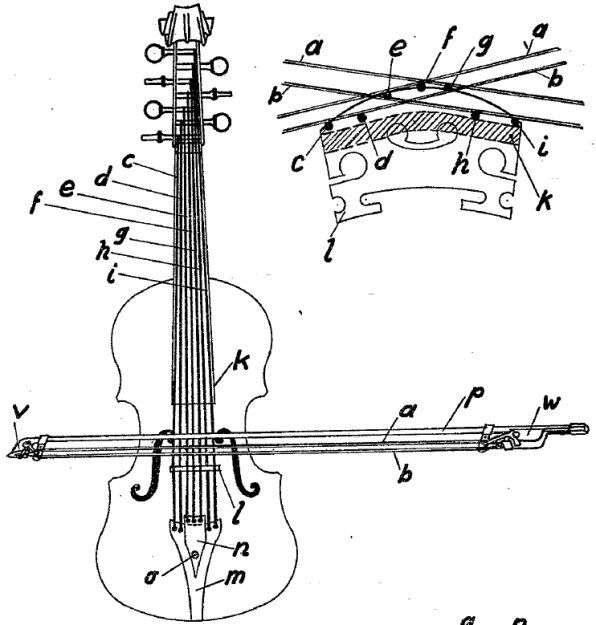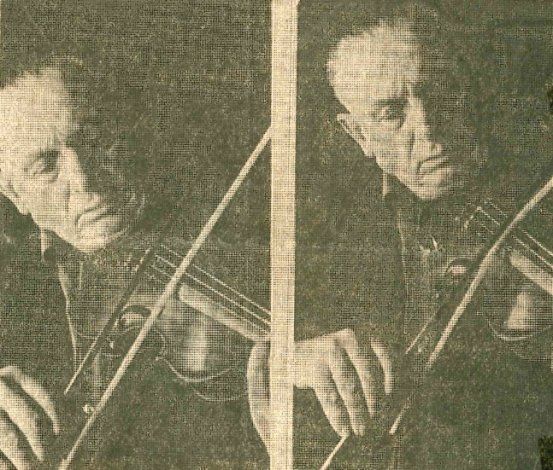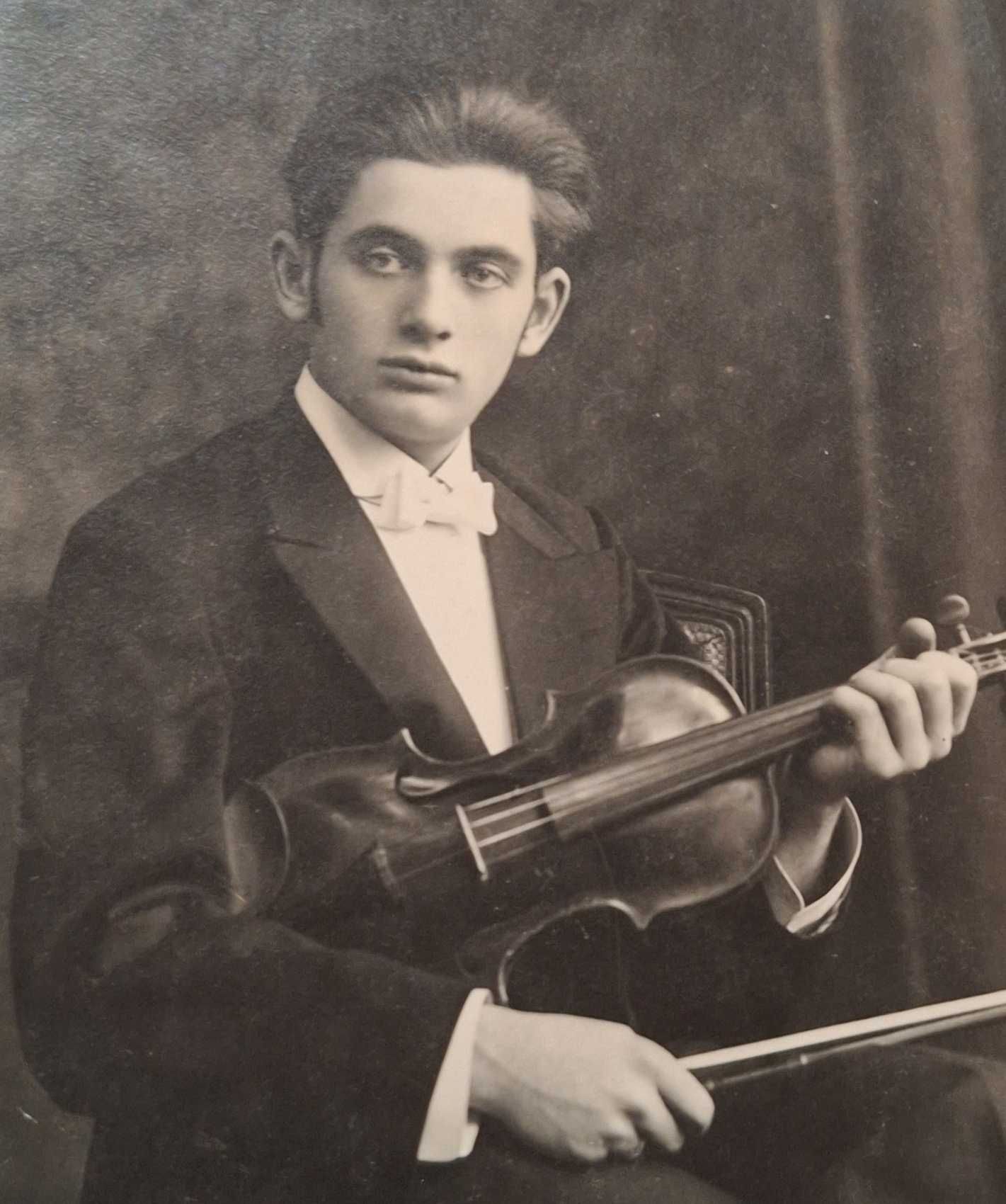Heinrich Treiber
Heinrich Treiber was born on 22 February 1899 in Eppelheim near Heidelberg (Germany). He studied violin, piano and composition in Heidelberg, Stuttgart and Erfurt. First he worked as a violinist in different orchestras and toured as a soloist with his "Treibergeige". Then Heinrich Treiber became conductor of the "Kurorchester" of Bad Wildungen, Bad Pyrmont and Bad Tölz. After this conducting intermezzo he returned to the violin and took the position of the concertmaster first at the symphony orchestra in Aachen, later in Eisenach, a position he held for many years.
Heinrich Treiber, who also used the pseudonym "Treiber von der Treib", invented a 7-string-violin in the 1920s, the so called "Treibergeige" and composed music for this instrument. He was quite famous for this invention and for playing on the instrument and was a special guest to many revues in the late 1920s and 1930s. Later he constructed a similar 7-string viola. Beside the compositions for his invented instruments Heinrich Treiber also composed serious music for orchestra and chamber music as well as songs and works for light orchestra.
Around 1950 Heinrich Treiber moved back to native soil and lived first in Ilvesheim, later in Rödersheim. He died in Rödersheim on 7 February 1977.
Treibergeige & Polyphonbogen
Heinrich Treiber invented a 7-string violin at the time around 1920. He filed a patent for this violin on 19.11.1922 at the Deutsches Reichspatentamt (file number T 27135) and was granted a patent on 20 July 1923 (Deutsches Reichspatent D.R.P 378582).
This patent was granted for any string instrument, on which the numerous strings are arranged on the bridge in such a way that a bow with doubled hair can play these strings.
For the 7-string violin by Heinrich Treiber this means there are the same strings like on the normal violin (tuned in fifths), but a, e and d come twice. Three of these 7 strings are arranged on a slightly higher bridge. The special bow has a hair devider at the tip and frog that holds the two hanks of hair parallel. Before playing the violinist has to feed the lower hank of hairs of the bow between the normal and higher strings of the violin. After this preparation it is possible to play 3 strings with the lower hank of hair and 2 strings with the upper hank of hair at the same time, making it a maximum of 5 strings played simultaneously.
Here is the sketch of the tip and frog of the special bow:

Here is the sketch of the whole violin and on the upper right side the cross section of the violin with the bridge, the three elevated strings in the middle (numbered e, f, g) and the illustration how the two hanks of hair from the bow can play 5 strings at a time:

If you are interested in the whole patent (in German!), you can download it here:
Heinrich Treiber also composed music for this special violin. For a complete listing please scroll down, but to get an impression about the possibilities of this "Treibergeige" you can find below the score of the "Prelude for 7-string Treibergeige op.2" from 1925 by Heinrich Treiber.
Heinrich Treiber owned both a 7-stringed violin and a 7-stringed viola, both unique instruments. They were built by luthier Emil Burkhardt in Eisenach in 1923. Nowadays they are archived at the Musical Instruments Collection of the Deutsches Museum in Munich. The Treiber-Violin is archived under the registration number 78-25, the Treiber-Viola under 78-26.
Polyphonbogen
Over the years Heinrich Treiber von der Treib had to notice that his 7-string violin remained unpopular among both violinists and composers. The reason for this ignorance was the immense difficulty to perform on this instrument and no other violinist took the time and efforts to master it. So Heinrich Treiber searched for other, easier ways to create a similar sound and finally in 1966 patented the so-called "Polyphonbogen".
This kind of bow was invented for the normal 4-string violin, looked similar to a normal violin bow at a first glance and could be used like a normal bow. But in addition to a normal bow the tension of the hair in this Polyphonbogen could be activated or deactived by a small spring. When the violinist pressed the spring the tension of the hair was reduced and it was possible to play all four strings at a time. Below is a demonstration by Heinrich Treiber von der Treib with his "Polyphonbogen". Left side: deactived spring and normal hair tension; right side: activated spring and reduced hair tension:

Below you can find scores of a few compositions by Heinrich Treiber von der Treib. At the end one can find a complete list of the manuscripts in my archive.
Heinrich Treiber von der Treib: Suite for violin alone (1925)
Heinrich Treiber von der Treib: String quartet (1949)
Heinrich Treiber von der Treib: Am Meer, for orchestra op.14 (1922)
Heinrich Treiber Archive
The following manuscripts are part of my Heinrich Treiber archive:
1) orchestra music
- Der Totentanz von Goethe, for orchestra op.3 (1921)
- Am Meer, for orchestra op.14 (1922)
- Erinnerung an Tegernsee, for orchestra (1922)
- 3 nordische Tänze, for orchestra (1923)
- Walzer „Lieb und Leben“, for orchestra op.25 (1923)
- Ballade vom verlassenen Mägdelein, for ensemble op.12 (1925)
- Polarlicht, for orchestra op.74 (1926)
- Festmarsch „Alt-Eisenach“, for orchestra (1926)
- Idyll, for orchestra (1926)
- Heil Oldesloe!, for orchestra op.92 (1928)
- An Schleswig-Holstein, for orchestra op.95 (1928)
- Auf Wiedersehn in Oldesloe, for orchestra op.96 (1928)
- Revue-Ouvertüre, for orchestra op.100 (1928)
- Hanseaten-Marsch, for orchestra (1928)
- Marsch „Adlerflug“, for brass band (1931)
- Revue „Flammende Herzen“, for orchestra (1939)
- Frühlingslied, for orchestra (1941)
- In der Wüste, for orchestra (1942)
- Semlianka, for brass band (1946)
- Thüringer Festmusik, for orchestra (1946)
- Der letzte Gang, for orchestra
- Der Stahlhelm-Marsch, for orchestra
2) chamber music
- Hymne „Gelobt sei uns dieser Tag“, for alto, organ, 2 clarinets and strings op.5 (1922)
- 4 kleine Studien, for viola (or cello) and piano op.11 (1922)
- Gavotte, for violin (or cello) and piano op.17a (1923)
- Gavotte, for violin op.17b (1923)
- An das Schicksal, for violin, viola and piano op.28 (1924)
- Hoffnung (Melancholie), for violin and piano op.31 (1924)
- Albumblatt, for violin and piano (1925)
- Fantasy on „O sole mio“, for violin, cello and piano op.75 (1926)
- Lullabij, for violin and piano op.77 (1926)
- Prelude for violin and piano (1926)
- Geburtstagsständchen, for cello and piano op.85 (1927)
- Flirt, for piano (1927)
- Abendlied, for violin and piano op.101 (1930)
- Ungarisches Lied, for violin and piano op.101 (1930)
- Coolsingel, for zither and violin (1931)
- Kleine Hausmusik, for violin and piano (1931)
- Romanze, for violin and piano (1931)
- Walzer „Man braucht nur ein klein bisser'l Glück“, for piano (1931)
- 3x3=9ne, for piano (1932)
- d'Ulmer Spatzen, for piano and zither (1932)
- Der kleine Musikant, for zither (1932)
- Hungaria, for violin and piano (1932)
- Krontjong-Marsch, for piano (1932)
- Ländler, for violin and piano (1932)
- Romanze „Wintersonne“,for violin, cello and piano (1932)
- Spanischer Walzer, for accordeon (1932)
- Trio for violin, cello and piano „Traumbilder“ (1932)
- Air von Hamm, for violin (1934)
- Air for violin and piano (1935)
- Suite for flute, piano and tamtam „Auf einer Schlangenfarm“ (1938)
- Aria for viola d'amore and piano (1939)
- Romanze, for viola and piano (1939)
- Suite for violin solo (1939)
- Aus meiner Heimat, for violin and piano (1940)
- Geburtstagsständchen, for 2 violins (1940)
- Humoristische Veränderungen des Schlagers „Ich hab mein Herz in Heidelberg verloren“, for violin and piano (1940)
- Kleine Abendmusik, for 2 violins (1940)
- Leichte Muse, for violin and piano (1940)
- Arabische Hirtenmusik, for flute and piano (1940)
- Walzer, for 2 violins (1940)
- Ikonische Spiele – ein Marschintermezzo, for piano (1942)
- In der Wüste, for accordeon / for flute, oboe, clarinet and harp (1942)
- Narrenzug, for piano (1942)
- Largo for 3 violins (1943)
- Meditative Chiesa, for 3 violins and voice ad lib. (1945)
- 4 einfache steyrische Ländler, for 2 violins and zither (1948)
- String quartet (1949)
- Potpourrie, for violin and piano „Alte Bekannte“ (1957)
- Der letzte Gang, for violin and piano
- Die Schrammler, for piano
- Polka „Und kommt die schwarze Katze...“, for piano
- Thema einer Sarabande – und Variationen, for 3 flutes and piano
- Unser Zeppelin, for piano
- Walzer „Flammende Herzen“, for piano
3) works for the 7-string "Treiber" violin/viola
- Prelude for 7-string „Treibergeige“ op.2 (1925)
- Feierliche Abendmusik, for 7-string „Treiberbratsche“ (1939)
- Largo for 7-string „Treibergeige“ (1943)
- Sonate im alten Stil, for 7-string „Treibergeige“ and piano (1943)
- Legende, for 7-string „Treiberbratsche“
- Potpourrie Nr.1, for 7-string „Treibergeige“
- Potpourrie Nr.2, for 7-string „Treibergeige“
4) vocal music
- Schlafliedchen, for voice and piano (1919)
- Einer Unbekannten, for voice and piano/orchestra (1920)
- Ellen..., for voice and piano (1920)
- Ich hatte einst..., for voice and piano (1920)
- Nicht traurig sein, for voice and piano (1920)
- Sei mein Weib, for voice and piano (1920)
- Stilles Gedenken, for voice and piano/orchestra (1920)
- Wär es noch so..., for voice and piano/orchestra (revised title: Wär ich noch jung....) (1920)
- Ich wandle einsam, for voice and piano op.8 (1921)
- Klage, for voice and piano op.10a (1921)
- Im Feld, for voice and piano op.10b (1921)
- Das verlassene Mägdlein, for voice and piano op.13 (text by: Eduard Mörike) (1922)
- O Friede, komm..., for voice and piano/orchestra op.21 (1923)
- Wartburglied, for voice and piano op.22 (text by: Ludwig Treiber) (1923)
- Was blickt von steiler Bergeshöh'?, for voice and piano (text by: Ludwig Treiber) (1923)
- Glück auf, for voice and piano op.26 (1924)
- Das „Jajalied“, for voice and piano op.27 (1924)
- Frühlingszauber, for voice and piano op.29 (1924)
- Gebet, for voice and piano op.30 (1924)
- Glückes überall, for voice and piano/orchestra op.36 (1924)
- Perkeos Klage, from the operetta „Das Heidelberger Fass“, for voice and piano op.53b (1924)
- Die Leidenden, for voice and piano op.55 (text by: Hermann Hesse) (1924)
- Eine muss die Schönste sein, for voice and piano (text by: Gustav Hochstetter) (1924)
- Hätt's nie gedacht, for voice and piano op.38 (text by: Eva Schering) (1925)
- Campagna, for voice and piano (text by: Heinz Hell) (1925)
- Gruß eines Churpfälzers an die Schwesterstadt Eisenach, for mens chorus and orchestra (1925)
- Ich hab' ein Herz in Eisenach gefunden, for voice and piano op.76 (1926)
- Heimatlied, for voice and piano (1926)
- Wenn mich nicht die Sinne trügen, for voice and piano (1926)
- Alt Eisenach, die Feine!, for chorus op.81 (1927)
- Ein Prinz reist durch die Lande, for voice and piano/orchestra op.82 (text by: Johann Ilht) (1927)
- Man sieht sich, lernt sich kennen, for voice and piano (1927)
- Walzerlied, from the operetta „Das Heidelberger Fass“, for voice and piano (1927)
- Das Lied vom Dienstmann Muck, from the operetta „Das Heidelberger Fass“, for voice and piano (1927)
- Zukunft, for voice and piano op.100 (text by: Lulu von Strauß und Torney) (1928)
- Weinlied, for voice and piano op.98 (text by: Heinrich Treiber von der Treib) (1930)
- Im 7. Himmel, for voice and orchestra op.99 (1930)
- Der Churpfalzgruß aus Eisenach, for chorus and orchestra (1937)
- Eisenach, du deutsche Perle, for voice and orchestra (1937)
- Verrat, for voice and piano (1937)
- Mütter, for voice and piano (text by: Erika von Kunhardt) (1941)
- Der grüne Leuchter, for voice and piano (1942)
- Seltsam im Nebel zu wandern, for voice and piano (text by: Hermann Hesse) (1942)
- Ballade „Der Wassermann“, for voice and piano (text by: Justinus Kerner) (1943)
- Das verklungene Lied, for voice and orchestra (text by: Maximilian Böttcher) (1943)
- Ewige Sehnsucht, for voice and piano (text by: Erna Berndt) (1943)
- Herzliebster Musikante, for voice and piano 1943 Mutter, for voice and piano (text by: Charlotte Weusch) (1943)
- 1946 Menschen, for voice and piano (text by: Franz Hammer) (1946)
- 1946 Wiegenlied, for voice and piano (1946)
- Mein Pech, for voice and piano (text by: Arthur Pserhofer) (1947)
- Sommerfreude, for voice and piano (1947)
- Das Lied der Pfalz, for voice and piano (text by: Heinrich Treiber von der Treib) (1963)
- Denn kommt die schwarze Katze, for voice and piano (text by: Heinrich Treiber von der Treib) (1966)
- Die Augen meines Kindes, for voice and piano
- Heimatlos, for voice and piano
- Ich träumt' im weiten Walde, for voice and piano
- Lisels Auftrittslied, for voice and piano
- Mein flatterhaftes Herz, for voice and piano
- Nebel am Perlacher Forst, for voice and piano (text by: Charlotte Weusch)
- Rosenrot, rosenrot, for voice and piano
- Sehnsucht, for voice and piano
- Warum denn gleich so aufgeregt?, for voice and piano (text by: Heinrich Treiber von der Treib)
- Wiegenlied, for voice and piano
5) arrangements
- Meditation (after Gounods „Ave Maria) (1920)
- Serenade by Franz Drdla
- Romanze by Heinrich Panofka
- Konzertwalzer by Fritz Schärneck

with his regular violin

with his 7-string violin